Family:
Fabaceae
Daviesia leptophylla
Slender Bitter-pea
(syn. D. virgata)
Other Names:

Name Origin:
Daviesia — after botanist the Rev. Hugh Davies (1739-1821).
Regional Subspecies:
Similar Species:
Slender Bitter-pea has narrower ‘leaves’ and flowers slightly later than Narrow-leaf Bitter-pea (D. mimosoides).
Occurrence:
Regional:
Quite widespread in most catchments and districts. Less common in the drier areas to the west.
Australia:
NSW, Vic, SA.
Habitat:
Shrubland to dry sclerophyll forest, dry open sites, usually on skeletal soils.
Habit:
Broom-like erect shrub to 2 m high, upper branches often ‘leafless’, with dull yellow-green linear ‘leaves’ to 6.5 cm long.
Site Preference:
Well-drained soils. Tolerates frost.
Flowering:
Yellow and red-brown/orange, Oct-Dec.
Seed Collection:
Early Dec to late Jan. Monitor very closely as seeds released immediately or within 1-2 days of maturity. To ensure collection, cover fruiting branches with nylon stockings or paper bags after flowering. Ripe pods light-brown and brittle and rattle when shaken, with dark-coloured seed. May be difficult to obtain seed in useful quantities. Long storage life.
Propagation:
From scarified seed. Soak in near-boiling water for about 30 seconds, before cooling rapidly under flowing cold water. Alternatively soak in cold water for several hours. Dry to prevent rotting, before sowing. Germination takes 3-8 weeks. Suitable for direct seeding in pots (2-3 seeds per pot).
Regeneration:
From seed or suckers, particularly after fire.
VALUES:
Shade & Shelter:
Useful low-level cover in windbreaks.
Land Protection:
Useful understorey in recharge plantings. Legume — improves soil fertility through ‘fixing’ nitrogen.
Wildlife:
Good habitat. Flowers are a pollen and excellent nectar source for various native insects and birds.
Ornamental:
Very decorative. Interesting foliage and attractive perfumed flowers. Plant in clumps to form dense thickets for best effect. Pruning encourages dense growth.
